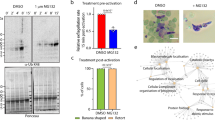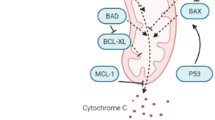Abstract
Intracellular leucoproliferative Theileria are unique as eukaryotic organisms that transform the immune cells of their ruminant host. Theileria utilize the uncontrolled proliferation for rapid multiplication and distribution into host daughter cells. The equal distribution of the schizont into the daughter cells is thought to be accomplished by a tight association with the host cell mitotic apparatus. In this study, we describe a highly conserved novel 37 kD Theileria annulata protein (TaSE). TaSE was found to be localized inside the parasite, the parasite membrane and within the host cell cytoplasm. Moreover, it co-localized at distinct points with host cell microtubules, which was especially apparent during mitosis, where co-localization was found with the centromere, the mitotic spindle and the midbody. Association of TaSE with the host cell tubulin network was corroborated by coimmunoprecipitation and transient transfection experiments. This is the first description of a theilerial protein co-localizing and potentially interacting with a host cell protein. The distribution of TaSE during mitosis makes it a protein to consider as playing a potential role for parasite distribution into daughter host cells.






Similar content being viewed by others
References
Ahmed JS, Rothert M, Steuber S, Schein E (1989) In vitro proliferative and cytotoxic responses of PBL from Theileria annulata-immune cattle. Zentralbl Veterinarmed 36:584–592
Andrews PD, Knatko E, Moore WJ, Swedlow JR (2003) Mitotic mechanics: the auroras come into view. Curr Opin Cell Biol 15:672–683
Bakheit MA, Endl E, Ahmed JS, Seitzer U (2006) Purification of macroschizonts of a Sudanese isolate of Theileria lestoquardi (T. lestoquardi [Atbara]). Ann NY Acad Sci 1081:453–462
Baumgartner M, Chaussepied M, Moreau MF, Werling D, Davis WC, Garcia A, Langsley G (2000) Constitutive PI3-K activity is essential for proliferation, but not survival, of Theileria parva-transformed B cells. Cell Microbiol 2:329–339
Baylis HA, Allsopp BA, Hall R, Carrington M (1993) Characterisation of a glutamine- and proline-rich protein (QP) from Theileria parva. Mol Biochem Parasitol 61:171–178
Bendtsen JD, Jensen LJ, Blom N, Von Heijne G, Brunak S (2004a) Feature-based prediction of non-classical and leaderless protein secretion. Protein Eng Des Sel 17:349–356
Bendtsen JD, Nielsen H, Von Heijne G, Brunak S (2004b) Improved prediction of signal peptides: SignalP 3.0. J Mol Biol 340:783–795
Biermann R, Schnittger L, Beyer D, Ahmed JS (2003) Initiation of translation and cellular localization of Theileria annulata casein kinase IIalpha: implication for its role in host cell transformation. J Cell Physiol 196:444–453
Brady G, Barbara M, Iscove N (1990) Representative in vitro cDNA amplification from individual hemopoetic cells and colonies. Methods Mol Cell Biol 2:17–25
Brown CG, Stagg DA, Purnell RE, Kanhai GK, Payne RC (1973) Infection and transformation of bovine lymphoid cells in vitro by infective particles of Theileria parva. Nature 245:101–103
Dobbelaere D, Heussler VT (1999) Transformation of leukocytes by Theileria parva and T. annulata. Annu Rev Microbiol 55:1–42
Dobbelaere DA, Kuenzi P (2004) The strategies of the Theileria parasite: a new twist in host–pathogen interactions. Curr Opin Immunol 16:524–530
Dobbelaere DA, Coquerelle TM, Roditi IJ, Eichhorn M, Williams RO (1988) Theileria parva. infection induces autocrine growth of bovine lymphocytes. Proc Natl Acad Sci USA 85:4730–4734
Ebel T, Middleton JF, Frisch A, Lipp J (1997) Characterization of a secretory type Theileria parva glutaredoxin homologue identified by a novel screening procedure. J Biol Chem 272:3042–3048
Fawcett D, Musoke A, Voigt W (1984) Interaction of sporozoites of Theileria parva with bovine lymphocytes in vitro. I. Early events after invasion. Tissue Cell 16:873–884
Galley Y, Hagens G, Glaser I, Davis W, Eichhorn M, Dobbelaere D (1997) Jun NH2-terminal kinase is constitutively activated in T cells transformed by the intracellular parasite Theileria parva. Proc Natl Acad Sci USA 94:5119–5124
Heussler VT (2002) Theileria survival strategies and host cell transformation. In: Dobbelaere DAE, McKeever D (eds) Theileria. Kluwer, Boston, pp 69–84
Heussler VT, Rottenberg S, Schwab R, Kuenzi P, Fernandez PC, McKellar S, Shiels B, Chen ZJ, Orth K, Wallach D, Dobbelaer D (2002) Hijacking of host cell IKK signalosomes by the transforming parasite Theileria. Science 298:1033–1036
Hulliger L, Wilde KH, Brown CG, Turner L (1964) Mode of multiplication of Theileria in cultures of bovine lymphocytic cells. Nature 203:728–730
Irvin AD, Ocama JG, Spooner PR (1982) Cycle of bovine lymphoblastoid cells parasitised by Theileria parva. Res Vet Sci 33:298–304
McHardy N (1984) Recent advances in the chemotherapy of theileriosis. Prev Vet Med 2:179–192
Nakamura Y, Gojobori T, Ikemura T (2000) Codon usage tabulated from the international DNA sequence databases: status for the year 2000. Nucleic Acids Res 28:292
Nielsen H, Engelbrecht J, Brunak S, von Heijne G (1997) Identification of prokaryotic and eukaryotic signal peptides and prediction of their cleavage sites. Protein Eng 10:1–6
ole-MoiYoi OK, Sugimoto C, Conrad PA, Macklin MD (1992) Cloning and characterization of the casein kinase II alpha subunit gene from the lymphocyte-transforming intracellular protozoan parasite Theileria parva. Biochemistry 31:6193–61202
Pipano E (1989) Vaccination against Theileria annulata theileriosis. In: Wright IG (ed) Veterinary protozoan and hemoparasite vaccines. CRC, London, pp 203–243
Sager H, Davis WC, Dobbelaere DA, Jungi TW (1997) Macrophage–parasite relationship in theileriosis. Reversible phenotypic and functional dedifferentiation of macrophages infected with Theileria annulata. J Leukoc Biol 61:459–468
Schneider I, Haller D, Seitzer U, Beyer D, Ahmed JS (2004) Molecular genetic characterization and subcellular localization of a putative Theileria annulata membrane protein. Parasitol Res 94:405–415
Schnittger L, Shayan P, Biermann R, Mehlhorn H, Gerdes J, Ahmed JS (2000) Molecular genetic characterization and subcellular localization of Theileria annulata mitochondrial heat-shock protein 70. Parasitol Res 86:444–452
Schnittger L, Katzer F, Biermann R, Shayan P, Boguslawski K, McKellar S, Beyer D, Shiels BR, Ahmed JS (2002) Characterization of a polymorphic Theileria annulata surface protein (TaSP) closely related to PIM of Theileria parva: implications for use in diagnostic tests and subunit vaccines. Mol Biochem Parasitol 120:247–256
Shaw MK (2003) Cell invasion by Theileria sporozoites. Trends Parasitol 19:2–6
Shaw MK, Tilney LG, Musoke AJ (1991) The entry of Theileria parva sporozoites into bovine lymphocytes: evidence for MHC class I involvement. J Cell Biol 113:87–101
Shiels BR, McKellar S, Katzer F, Lyons K, Kinnaird J, Ward C, Wastling JM, Swan D (2004) A Theileria annulata DNA binding protein localized to the host cell nucleus alters the phenotype of a bovine macrophage cell line. Eukaryot Cell 3:495–505
Skilton RA, Bishop RP, Wells CW, Spooner PR, Gobright E, Nkonge C, Musoke AJ, Macklin M, Iams KP (1998) Cloning and characterization of a 150 kDa microsphere antigen of Theileria parva that is immunologically cross-reactive with the polymorphic immunodominant molecule (PIM). Parasitology 117:321–330
Stagg DA, Chasey D, Young AS, Morzaria SP, Dolan TT (1980) Synchronization of the division of Theileria macroschizonts and their mammalian host cells. Ann Trop Med Parasitol 74:263–265
Swan DG, Phillips K, Tait A, Shiels BR (1999) Evidence for localisation of a Theileria parasite AT hook DNA-binding protein to the nucleus of immortalised bovine host cells. Mol Biochem Parasitol 101:117–129
Swan DG, Stadler L, Okan E, Hoffs M, Katzer F, Kinnaird J, McKellar S, Shiels BR (2003) TashHN, a Theileria annulata encoded protein transported to the host nucleus displays an association with attenuation of parasite differentiation. Cell Microbiol 5:947–956
Tilney LG, Tilney MS, Shaw MK (1994) Theileria: strategy of infection and survival. In: Russel DG (ed) Baillières clinical infectious diseases: strategies for intracellular survival of microbes. Baillère Tindall, London, pp 335–350
Zeitlin SG, Sullivan KF (2001) Animal cytokinesis: breaking up is hard to do. Curr Biol 11:R514–516
Acknowledgements
We thank Brian Shiels and Andy Tait (Department of Veterinary Parasitology, University of Glasgow) for providing piroplasm RNA and the 1C7 antibody, respectively. Acknowledgement of funding: the study was partially supported by EU grant number ICA4-CT-2000-30028.
Author information
Authors and Affiliations
Corresponding author
Rights and permissions
About this article
Cite this article
Schneider, I., Haller, D., Kullmann, B. et al. Identification, molecular characterization and subcellular localization of a Theileria annulata parasite protein secreted into the host cell cytoplasm. Parasitol Res 101, 1471–1482 (2007). https://doi.org/10.1007/s00436-007-0663-z
Received:
Accepted:
Published:
Issue Date:
DOI: https://doi.org/10.1007/s00436-007-0663-z




